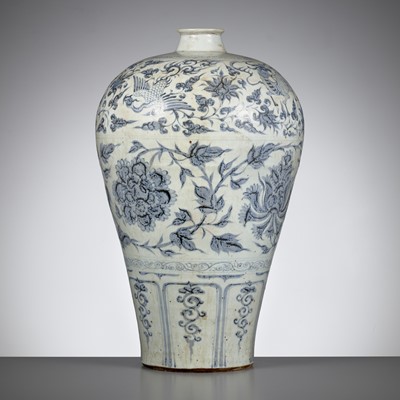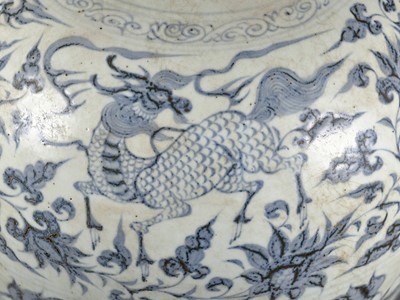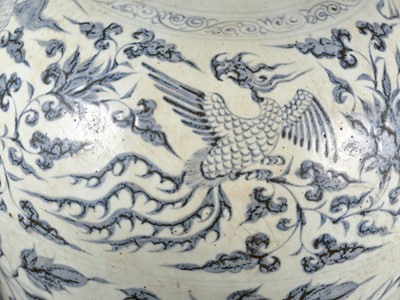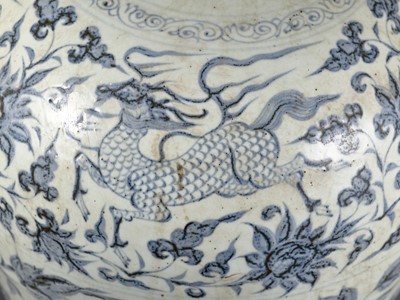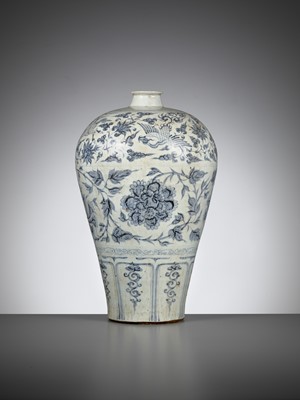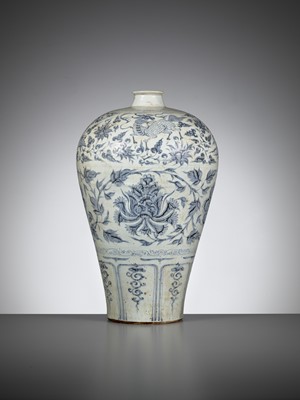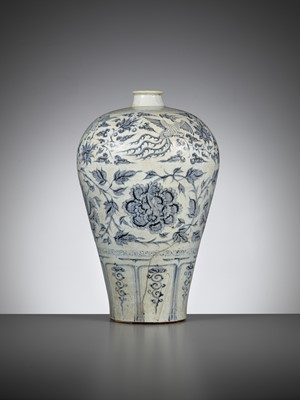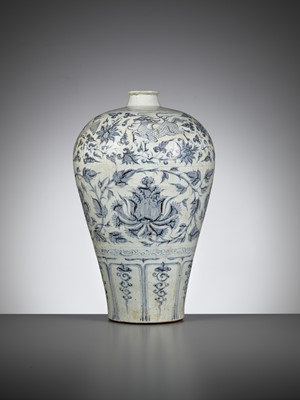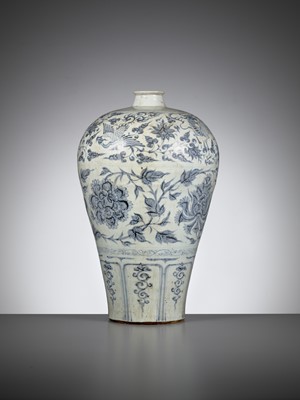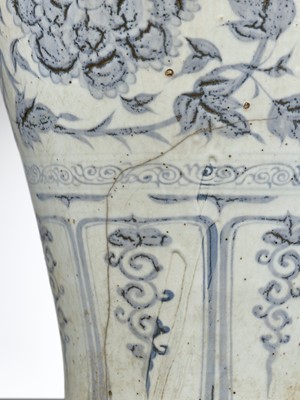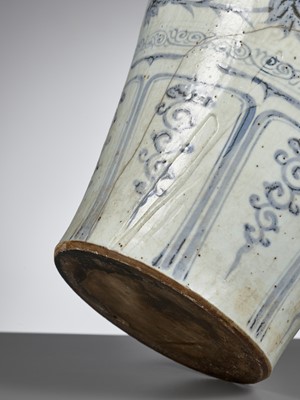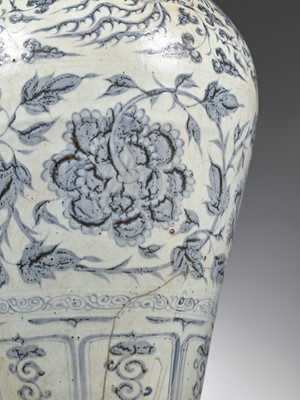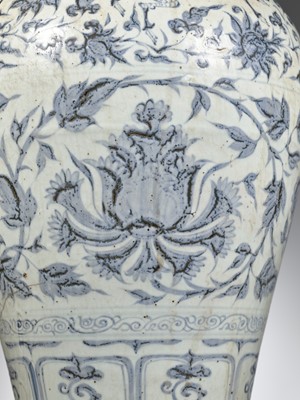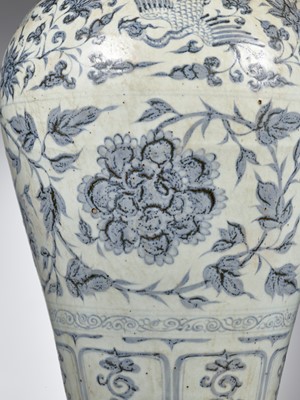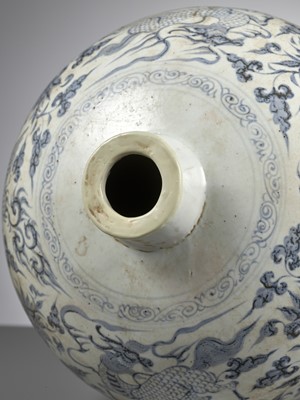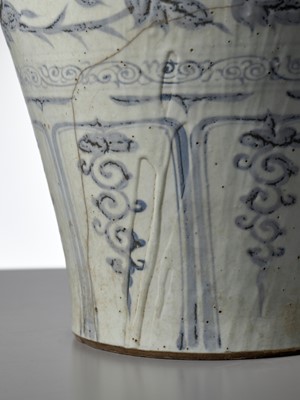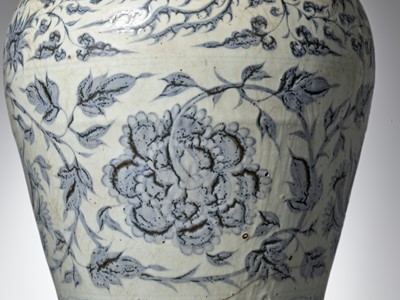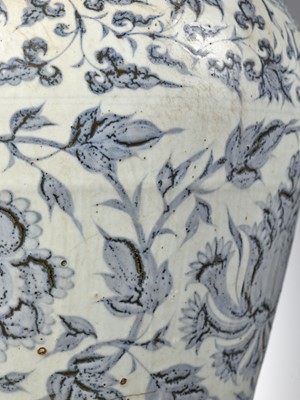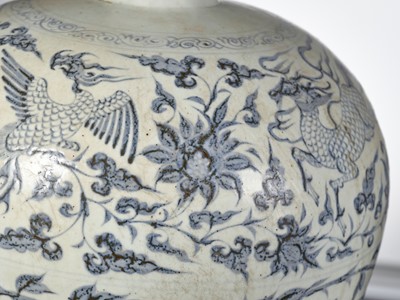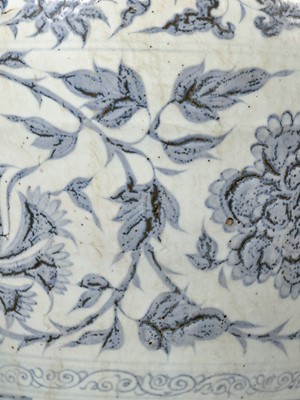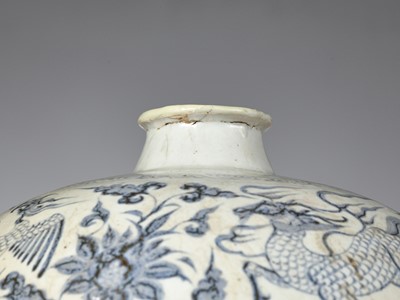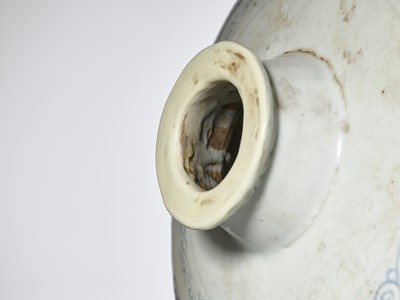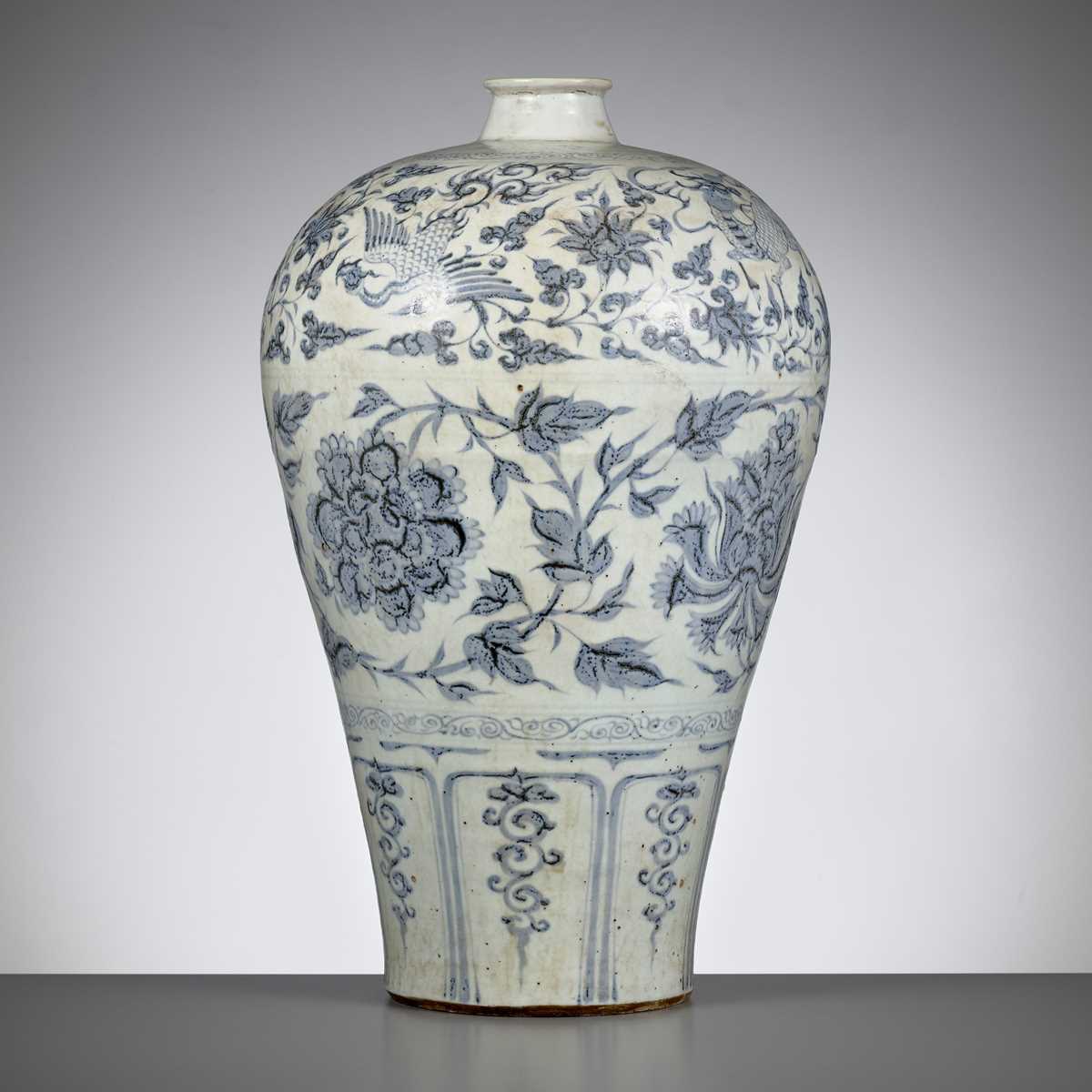11th Oct, 2023 11:00
THREE-DAY AUCTION - Fine Chinese Art / 中國藝術集珍 / Buddhism & Hinduism
79
A BLUE AND WHITE ‘PEONY, PHOENIX AND LONGMA’ VASE, MEIPING, CHINA, 14TH-15TH CENTURY
十四至十五世紀青花牡丹神獸梅瓶
Sold for €64,000
including Buyer's Premium
Finely painted in ample detail and neatly graduated shades of cobalt blue with a continuous undulating stem bearing four large peony blooms, each with furled petals. The stem growing spiky leaves on scrolling vines, all elaborated in stark contrasts of manifold pale and soft blue tones with innumerable minuscule dots of blackish blue, all between narrow bands of classic scroll and double lines. This main frame is beneath a masterfully painted band of phoenix and longma outlined in deep blue, detailing the fine scales, feathers, wings and tails of these mythical creatures, all enclosed by densely flowering lotus blossoms, and beneath a band of scroll design which encircles the short upright neck with its flared mouth rim. The base with a wide border of rectangular lappets. The broad shoulders elegantly tapering to a slightly splayed foot.
Provenance: Belgian trade. Acquired from the estate of a noble family in Belgium, where it has been for quite some time, by repute.
Condition: Old wear and weathering. Expected firing flaws, such as glaze gaps and recesses, glaze crackling, minute firing cracks, extensive pitting, minor kiln grit, and a circumferential luting line below the shoulder. One glaze recess is revealing some of the original blue color below the thick and somewhat opaque layer of transparent glaze above. The lower section with a single crack, which has become black over time. The base and the lip have been excised so that the vase could fit into a mounting. This was probably done in the 18th-19th century, shortly after the vase made its way to Europe. The mounting was then removed again, probably during the 20th century, and the base and lip were restored accordingly. This restoration was carried out a long time ago, for that the fills at the lip have turned yellow, now standing out against the original color of the ware.
Weight: 4,224 g
Dimensions: Height 43.2 cm
Please click here to read the full description
This elegant meiping is a classic example of early Chinese blue and white porcelain. The form is well-proportioned and the vessel sturdily yet elegantly potted. It is decorated in rich and well-graduated cobalt blue which had to be imported at great expense during this period. The banded design makes good use of the extensive canvas provided by the vase's form. The three major decorative bands are in pleasing contrast to one another. They include four of the most successful motifs of the 14th century: longma and phoenix, the bold peony scrolls, and the lappet panels.
The longma is an auspicious creature that, according to legend, is said to represent gratitude. During the Xuande reign it was introduced as a principal decoration and has been a popular subject ever since. While depictions of longma on porcelain from this period are quite common, earlier versions of it are quite rare to find.
Literature comparison:
Compare the form of the present lot and the longma and phoenix designs with several examples from the 14th century in Toji Taikei, Vol. 41, Gen no Sometsuke, by Yabe Yoshiaki, Publisher Heibonsha, Tokyo, Japan, 1974.
For the form:
Nr. 37, blue and white vase, Meiping, height 34.6 cm
For the phoenix:
Nr. 38, blue and white ‘’peony and scroll’’ vase, Meiping, height 43.7 cm
Nr. 66, blue and white ‘’seahorse and phoenix’’ vase, same item as Nr. 59, height 25.4 cm
For the longma:
Nr. 8, blue and white ‘’seahorse’’ plate, diameter 47 cm, Topkapı Palace Museum
Nr. 59, blue and white ‘’seahorse and phoenix’’ vase, same item as Nr. 66, height 25.4 cm
点此阅读中文翻译 (Chinese Translation)
十四至十五世紀青花牡丹神獸梅瓶
敞口,折沿,細長頸,扁鼓眶,圈足。青花精美四朵牡丹卷葉紋。青花色彩柔和,間雜黑藍色斑點。肩部滿飾卷草紋與神獸如鳳凰與龍馬,精美描繪了這些神話生物的鱗片、羽毛、翅膀和尾巴。下方是開光芭蕉紋内描繪卷草紋。
來源:比利時古玩交易,購於比利時貴族家庭,據説曾在家族裏很長時間。
品相:磨損和風化,有燒製缺陷,例如釉面凹陷和裂紋,大面積的凹坑、較小的窯砂,以及肩部下方的凹痕。一個釉槽在透明釉層下露出了一些原始的藍色。下部有一條裂紋,隨著時間的推移已經變黑。底座和邊緣已被切除,以便花瓶可以安裝到支架中。 這可能是在上十八世紀至十九世紀完成的,即花瓶傳入歐洲後不久。隨後,可能是在二十世紀,支架再次被拆除,底座和唇緣也相應修復。這次修復是很久以前的事情了,因為唇部的填充物已經變黃,現在在器物的原始顏色的襯托下顯得很突出。
重量:4,224 克
尺寸:高 43.2 厘米
此件典雅的梅瓶是中國早期青花瓷的經典之作。 器形勻稱,器質堅固,紋飾典雅。 以濃郁且漸變的鈷藍色裝飾,在這一時期必須花費巨資進口鈷料。三大裝飾帶彼此形成鮮明對比。 其中包括十四世紀最成功的四種圖案:龍馬和鳳凰、纏枝牡丹和芭蕉紋。
龍馬是一種瑞獸,相傳代表著感恩。 宣德年間,它成為主要裝飾,並從此成為流行的主題。 雖然這一時期瓷器上的龍馬圖案很常見,但早期版本卻很少見。
文獻比較:
比較幾件十四世紀的梅瓶,外形相似,或是有龍馬或鳳凰紋 ,收藏於Toji Taikei,Yabe Yoshiaki,卷四十一,《Gen no Sometsuke》,Heibonsha出版社,日本東京,1974年。
外形相似:
編號37,青花瓷梅瓶,高 34.6 釐米
有鳳凰紋裝飾:
編號38,青花牡丹唐草紋梅瓶,高 43.7 釐米
編號66,青花海馬鳳凰紋瓶,高 25.4 釐米
有龍馬紋裝飾:
編號8,青花海馬圖大盤,直徑 47 釐米,土耳其伊斯坦堡Topkapi皇宮
編號59,青花海馬鳳凰紋瓶,高 25.4 釐米
Finely painted in ample detail and neatly graduated shades of cobalt blue with a continuous undulating stem bearing four large peony blooms, each with furled petals. The stem growing spiky leaves on scrolling vines, all elaborated in stark contrasts of manifold pale and soft blue tones with innumerable minuscule dots of blackish blue, all between narrow bands of classic scroll and double lines. This main frame is beneath a masterfully painted band of phoenix and longma outlined in deep blue, detailing the fine scales, feathers, wings and tails of these mythical creatures, all enclosed by densely flowering lotus blossoms, and beneath a band of scroll design which encircles the short upright neck with its flared mouth rim. The base with a wide border of rectangular lappets. The broad shoulders elegantly tapering to a slightly splayed foot.
Provenance: Belgian trade. Acquired from the estate of a noble family in Belgium, where it has been for quite some time, by repute.
Condition: Old wear and weathering. Expected firing flaws, such as glaze gaps and recesses, glaze crackling, minute firing cracks, extensive pitting, minor kiln grit, and a circumferential luting line below the shoulder. One glaze recess is revealing some of the original blue color below the thick and somewhat opaque layer of transparent glaze above. The lower section with a single crack, which has become black over time. The base and the lip have been excised so that the vase could fit into a mounting. This was probably done in the 18th-19th century, shortly after the vase made its way to Europe. The mounting was then removed again, probably during the 20th century, and the base and lip were restored accordingly. This restoration was carried out a long time ago, for that the fills at the lip have turned yellow, now standing out against the original color of the ware.
Weight: 4,224 g
Dimensions: Height 43.2 cm
Please click here to read the full description
This elegant meiping is a classic example of early Chinese blue and white porcelain. The form is well-proportioned and the vessel sturdily yet elegantly potted. It is decorated in rich and well-graduated cobalt blue which had to be imported at great expense during this period. The banded design makes good use of the extensive canvas provided by the vase's form. The three major decorative bands are in pleasing contrast to one another. They include four of the most successful motifs of the 14th century: longma and phoenix, the bold peony scrolls, and the lappet panels.
The longma is an auspicious creature that, according to legend, is said to represent gratitude. During the Xuande reign it was introduced as a principal decoration and has been a popular subject ever since. While depictions of longma on porcelain from this period are quite common, earlier versions of it are quite rare to find.
Literature comparison:
Compare the form of the present lot and the longma and phoenix designs with several examples from the 14th century in Toji Taikei, Vol. 41, Gen no Sometsuke, by Yabe Yoshiaki, Publisher Heibonsha, Tokyo, Japan, 1974.
For the form:
Nr. 37, blue and white vase, Meiping, height 34.6 cm
For the phoenix:
Nr. 38, blue and white ‘’peony and scroll’’ vase, Meiping, height 43.7 cm
Nr. 66, blue and white ‘’seahorse and phoenix’’ vase, same item as Nr. 59, height 25.4 cm
For the longma:
Nr. 8, blue and white ‘’seahorse’’ plate, diameter 47 cm, Topkapı Palace Museum
Nr. 59, blue and white ‘’seahorse and phoenix’’ vase, same item as Nr. 66, height 25.4 cm
点此阅读中文翻译 (Chinese Translation)
十四至十五世紀青花牡丹神獸梅瓶
敞口,折沿,細長頸,扁鼓眶,圈足。青花精美四朵牡丹卷葉紋。青花色彩柔和,間雜黑藍色斑點。肩部滿飾卷草紋與神獸如鳳凰與龍馬,精美描繪了這些神話生物的鱗片、羽毛、翅膀和尾巴。下方是開光芭蕉紋内描繪卷草紋。
來源:比利時古玩交易,購於比利時貴族家庭,據説曾在家族裏很長時間。
品相:磨損和風化,有燒製缺陷,例如釉面凹陷和裂紋,大面積的凹坑、較小的窯砂,以及肩部下方的凹痕。一個釉槽在透明釉層下露出了一些原始的藍色。下部有一條裂紋,隨著時間的推移已經變黑。底座和邊緣已被切除,以便花瓶可以安裝到支架中。 這可能是在上十八世紀至十九世紀完成的,即花瓶傳入歐洲後不久。隨後,可能是在二十世紀,支架再次被拆除,底座和唇緣也相應修復。這次修復是很久以前的事情了,因為唇部的填充物已經變黃,現在在器物的原始顏色的襯托下顯得很突出。
重量:4,224 克
尺寸:高 43.2 厘米
此件典雅的梅瓶是中國早期青花瓷的經典之作。 器形勻稱,器質堅固,紋飾典雅。 以濃郁且漸變的鈷藍色裝飾,在這一時期必須花費巨資進口鈷料。三大裝飾帶彼此形成鮮明對比。 其中包括十四世紀最成功的四種圖案:龍馬和鳳凰、纏枝牡丹和芭蕉紋。
龍馬是一種瑞獸,相傳代表著感恩。 宣德年間,它成為主要裝飾,並從此成為流行的主題。 雖然這一時期瓷器上的龍馬圖案很常見,但早期版本卻很少見。
文獻比較:
比較幾件十四世紀的梅瓶,外形相似,或是有龍馬或鳳凰紋 ,收藏於Toji Taikei,Yabe Yoshiaki,卷四十一,《Gen no Sometsuke》,Heibonsha出版社,日本東京,1974年。
外形相似:
編號37,青花瓷梅瓶,高 34.6 釐米
有鳳凰紋裝飾:
編號38,青花牡丹唐草紋梅瓶,高 43.7 釐米
編號66,青花海馬鳳凰紋瓶,高 25.4 釐米
有龍馬紋裝飾:
編號8,青花海馬圖大盤,直徑 47 釐米,土耳其伊斯坦堡Topkapi皇宮
編號59,青花海馬鳳凰紋瓶,高 25.4 釐米
Zacke Live Online Bidding
Our online bidding platform makes it easier than ever to bid in our auctions! When you bid through our website, you can take advantage of our premium buyer's terms without incurring any additional online bidding surcharges.
To bid live online, you'll need to create an online account. Once your account is created and your identity is verified, you can register to bid in an auction up to 12 hours before the auction begins.
Intended Spend and Bid Limits
When you register to bid in an online auction, you will need to share your intended maximum spending budget for the auction. We will then review your intended spend and set a bid limit for you. Once you have pre-registered for a live online auction, you can see your intended spend and bid limit by going to 'Account Settings' and clicking on 'Live Bidding Registrations'.
Your bid limit will be the maximum amount you can bid during the auction. Your bid limit is for the hammer price and is not affected by the buyer’s premium and VAT. For example, if you have a bid limit of €1,000 and place two winning bids for €300 and €200, then you will only be able to bid €500 for the rest of the auction. If you try to place a bid that is higher than €500, you will not be able to do so.
Online Absentee and Telephone Bids
You can now leave absentee and telephone bids on our website!
Absentee Bidding
Once you've created an account and your identity is verified, you can leave your absentee bid directly on the lot page. We will contact you when your bids have been confirmed.
Telephone Bidding
Once you've created an account and your identity is verified, you can leave telephone bids online. We will contact you when your bids have been confirmed.
Classic Absentee and Telephone Bidding Form
You can still submit absentee and telephone bids by email or fax if you prefer. Simply fill out the Absentee Bidding/Telephone bidding form and return it to us by email at office@zacke.at or by fax at +43 (1) 532 04 52 20. You can download the PDF from our Upcoming Auctions page.
How-To Guides
How to Create Your Personal Zacke Account
How to Register to Bid on Zacke Live
How to Leave Absentee Bids Online
How to Leave Telephone Bids Online
中文版本的操作指南
创建新账号
注册Zacke Live在线直播竞拍(免平台费)
缺席投标和电话投标
Third-Party Bidding
We partner with best-in-class third-party partners to make it easy for you to bid online in the channel of your choice. Please note that if you bid with one of our third-party online partners, then there will be a live bidding surcharge on top of your final purchase price. You can find all of our fees here. Here's a full list of our third-party partners:
- 51 Bid Live
- EpaiLive
- ArtFoxLive
- Invaluable
- LiveAuctioneers
- the-saleroom
- lot-tissimo
- Drouot
Please note that we place different auctions on different platforms. For example, in general, we only place Chinese art auctions on 51 Bid Live.
Bidding in Person
You must register to bid in person and will be assigned a paddle at the auction. Please contact us at office@zacke.at or +43 (1) 532 04 52 for the latest local health and safety guidelines.
